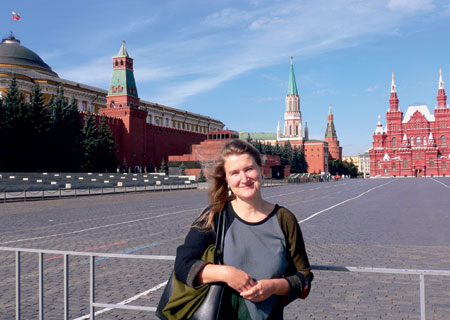Back

Jessica
Gogan, The Warhol’s assistant director
for education and interpretation, in front of Red Square
in Moscow.
Putting together a major traveling exhibition—with
an educational program and a companion catalog—is
both challenging and rewarding for all involved. When the
exhibition is being designed for display in a foreign country,
the unique challenges make the experience all the more
worthwhile.
The Andy Warhol Museum’s John Smith and
Jessica Gogan both admit they felt a bit of culture shock
while working
and traveling in Russia to organize the exhibition Andy
Warhol: Artist of Modern Life and companion educational
programs for a three-city tour. But they also agree it
was a learning experience and a rare opportunity to bring
Warhol’s art to new audiences.
Sponsored by the Alcoa
Foundation and Alcoa, which has two fabricating plants
in Russia, Andy Warhol: Artist of
Modern Life featured more than 300 of Warhol’s paintings,
drawings, photographs, films, and archival material, and
helped establish a connection between Pittsburgh—where
Alcoa was founded—and communities in Moscow, St.
Petersburg, and Samara, Russia, which are now home to many
new Alcoa employees.
There were dozens of people involved
in organizing the exhibition and making it a success, including
a diverse
group of staff from each of The Warhol’s departments.
Over the course of 13 months, Smith, Gogan and several
other staff members traveled to Russia to meet their Russian
counterparts, explore the venues selected to house the
show, and develop
public programming around the exhibition.
According to Smith,
the museum’s assistant director
for collections and research, language was a big challenge
in coordinating the exhibition. “It was exhausting
always having to speak through translators,” he says. “The
language barrier inevitably forces you to slow down and
really think about what you want to say.
“
We also found that our Russian colleagues don’t rely
heavily on email the same way that we do. So, there was
certainly a learning curve when it came to communication,
but once we better understood the way our colleagues worked,
we were able to adapt our normal modes a bit.”
Gogan,
The Warhol’s assistant director for education
and interpretation, was intrigued by what she saw of Russia’s
education system, both in the schools and in the museums. “I
was impressed by the sophistication of some of the education
programs I saw. I visited one institution in Moscow that
was an art, architecture, and design school that elementary
to high school-age children could attend.”
Both Smith
and Gogan found the cosmopolitan cities of Moscow, St.
Petersburg, and Samara to be very different than the
Russia of bygone stereotypes. Yet the
sheer number of trendy, expensive shops, luxury car ads, and similar signs of
consumerism fueled by the country’s recent and rapid growth still surprised
them.
“
In Samara, a primarily industrial city on the Volga River, I wandered around
and found stores selling Max Mara fashions and Cacharel fragrances from France,” says
Gogan. “When I learned that the average income is only $5,000 a year, I
didn’t expect to see such a market for foreign luxury goods, but clearly,
there is a demand.”
The Pop of Perestroika
Apparently, there is also a demand for Pop and contemporary
art. Andy Warhol: Artist of Modern Life has been drawing
record crowds in Russia. Smith reports that more than
100,000 people saw the exhibition in Moscow, though it
was there less than two months, and about 20,000 people
attended during the opening weekend in St. Petersburg.
“
The show has been unbelievably successful. It’s exceeded
everyone’s wildest dreams,” Smith notes, adding, “The
press coverage was just a madhouse.”
In Moscow, the
exhibition opened in conjunction with a Russian Pop Art
show. During a youth workshop she led,
Gogan discovered the students identified more with the
Warhol exhibition than they did the Russian one. “For
them, Warhol was very fresh and very much about the everyday.
I think the simplicity of Warhol’s work was the real
appeal,” she says.
“
It’s going to be really interesting to see how the
next 10 years evolve in Moscow. There’s a very entrepreneurial
spirit, but the levels of bureaucracy are still there.
One minute, you feel like you’re in the 21st century,
and the next you’re back in the ‘70s.”
“
It really is a city in enormous flux,” says Smith. “You’d
look out your hotel window and all you would see were cranes
and construction.”
The highlight of the experience
for Smith was not Moscow, but St. Petersburg—a beautiful
city, with a slower, more enjoyable pace than Moscow. While
there, he explored
one of the city’s cultural treasures —the Hermitage
Museum. Considered to be one of the world’s most
magnificent museums, it is an opulent palace dating to
the 1700s filled with masterpieces from throughout history.
Says Smith: “I remember thinking to myself while
I was there that whatever challenges I may have had pulling
this together, it was all worth it. And to be able to bring
Warhol’s art to audiences that were really hungry
for it was an honor.”
Andy Warhol: Artist of Modern
Life will be on view in Samara, Russia, March 6 through April
24.
Back
| Top |